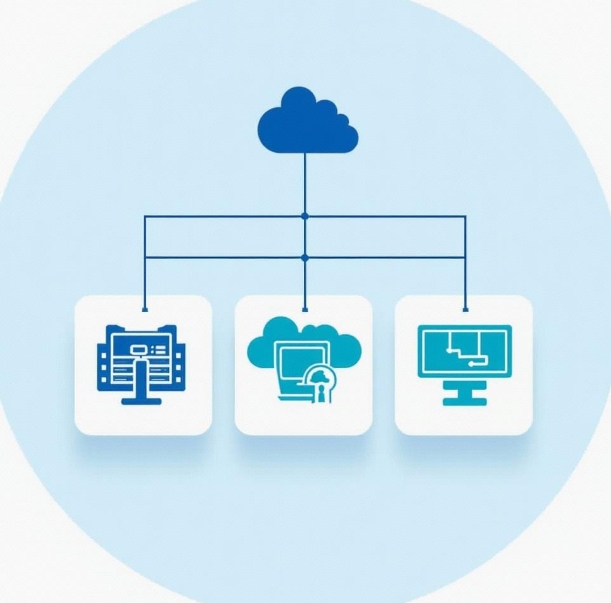How can enterprises leverage cloud computing to enhance operational efficiency and flexibility?
- latest articles
- 1.DApp Development & Customization: Merging Diverse Market Needs with User Experience 2.Analysis of the Core Technical System in DApp Project Development 3.How to achieve cross-chain interoperability in Web3 projects? 4.How does the tokenization of points reconstruct the e-commerce ecosystem? 5.How to Set and Track Data Metrics for a Points Mall? 6.What is DApp Development? Core Concepts and Technical Analysis 7.Inventory of commonly used Web3 development tools and usage tips 8.Development of a Distribution System Integrated with Social E-commerce 9.Six Key Steps for Businesses to Build a Points Mall System 10.What is DApp Development? A Comprehensive Guide from Concept to Implementation
- Popular Articles
- 1.Future Trends and Technology Predictions for APP Development in 2025 2.Analysis of the DeFi Ecosystem: How Developers Can Participate in Decentralized Finance Innovation 3.From Zero to One: How PI Mall Revolutionizes the Traditional E-commerce Model 4.DAPP Development | Best Practices for Professional Customization and Rapid Launch 5.Recommended by the Web3 developer community: the most noteworthy forums and resources 6.From Cloud Computing to Computing Power Leasing: Building a Flexible and Scalable Computing Resource Platform 7.How to Develop a Successful Douyin Mini Program: Technical Architecture and Best Practices 8.Shared Bike System APP: The Convenient Choice in the Era of Smart Travel 9.How to Create a Successful Dating App: From Needs Analysis to User Experience Design 10.From Design to Development: The Complete Process of Bringing an APP Idea to Life
With the rapid development of information technology, cloud computing has become a crucial force driving enterprise digital transformation. It not only provides businesses with low-cost, high-performance IT resources but also delivers faster and more dynamic operational capabilities through flexible deployment methods. This article will explore how enterprises can leverage cloud computing to enhance operational efficiency and flexibility, providing an in-depth analysis of its specific applications in business operations and the significant advantages it brings.
I. Basic Concepts and Advantages of Cloud Computing
Cloud computing refers to a service model that delivers computing, storage, data, and application resources to users on-demand via the internet. Based on virtualization technology, it enables computing resources, storage resources, and software services to be provided as services, freeing users from concerns about maintaining and managing underlying hardware. Common cloud computing services include Infrastructure as a Service (IaaS), Platform as a Service (PaaS), and Software as a Service (SaaS).
The main advantages of cloud computing include:
Cost Reduction: Traditional enterprises require significant investment in building and maintaining IT infrastructure, whereas cloud computing, with its pay-as-you-go model, substantially lowers IT costs.
Elastic Scalability: Cloud computing allows businesses to scale resources up or down as needed, avoiding resource waste and accommodating uncertain business demands.
High Availability and Disaster Recovery: Cloud service providers typically deploy backup and redundancy measures across multiple data centers, ensuring high system availability and data security.
Rapid Deployment and Innovation: Services and applications on cloud platforms can be deployed quickly, enabling businesses to respond faster to market demands and accelerate product and service innovation.
II. How Cloud Computing Enhances Enterprise Operational Efficiency
In a highly competitive market, enterprises must improve operational efficiency to maintain their edge. Cloud computing plays a significant role in enhancing operational efficiency, specifically in the following areas:
1. Automation and Intelligent Management
Cloud computing platforms offer a wealth of automation tools, allowing businesses to simplify IT infrastructure management through automated systems. For example, enterprises can utilize cloud computing's automated deployment features to install and configure applications automatically, significantly saving manual operation time. Additionally, cloud platforms include intelligent monitoring and management functions that can monitor the IT environment in real-time and automatically troubleshoot and fix issues, reducing the risk of human error and system downtime.
2. Reduced System Downtime
Through multiple redundancy designs and automatic failover technologies, cloud computing platforms ensure that enterprise systems and services can operate 24/7 without interruption. The high availability of cloud computing not only improves system stability but also ensures that global business operations are unaffected by downtime. This is particularly critical for globally operating enterprises.
3. Resource Optimization and Cost Control
Resource scheduling and load balancing technologies provided by cloud platforms help enterprises optimize resource allocation and improve resource utilization efficiency. With cloud computing, businesses can dynamically adjust resources based on actual needs, eliminating the necessity to reserve excessive resources for seasonal fluctuations or unexpected business peaks, thereby effectively controlling costs. For instance, during peak sales seasons, enterprises can temporarily increase computing and storage resources, while reducing usage during off-peak periods, avoiding hardware surplus or shortage.
4. Global Collaboration and Data Sharing
Cloud computing enables enterprises to break through geographical and time constraints, achieving global collaboration and data sharing. Employees can access and share data via the cloud platform from anywhere, greatly enhancing team collaboration efficiency. Furthermore, cloud computing provides powerful data analysis capabilities, allowing businesses to gain business insights and optimize operational strategies through real-time analysis of large volumes of data.

III. How Cloud Computing Enhances Enterprise Flexibility
Flexibility is a competitive advantage for modern enterprises in a changing market environment. Cloud computing enhances enterprise flexibility in the following ways:
1. Agile Development and Rapid Iteration
Cloud computing provides enterprises with rich development platforms and tools that support agile development models. Businesses can use the development tools and environments offered by cloud platforms to quickly build and test new applications, enabling rapid product iteration. The elastic resources and automated deployment features of cloud computing help enterprises achieve quick resource allocation during development to meet rapidly changing market demands.
2. Lowering Technical Barriers
Cloud computing platforms offer a wide range of pre-built applications and services, allowing enterprises to launch complex IT services and applications with simple configurations. This significantly lowers the technical threshold, enabling businesses to use advanced technologies without needing large, specialized technical teams. For small and medium-sized enterprises, cloud computing is particularly important as it allows them to enjoy the technological advantages of larger companies at a lower cost.
3. Supporting Business Innovation
Cloud computing enables enterprises to test and deploy new business models more flexibly. For example, businesses can leverage cloud platforms' capabilities in artificial intelligence, the Internet of Things, and big data analytics to develop new products and services that meet evolving market demands. Cloud computing also supports resource and technology sharing with third-party partners, fostering ecosystem development and further driving business innovation and growth.
4. Hybrid Deployment of Cloud and On-Premises
During the transformation process, enterprises can choose to keep some core systems on-premises while migrating other non-core systems to the cloud. Hybrid cloud architecture allows businesses to flexibly combine cloud computing with traditional IT infrastructure while ensuring data security and business stability. This flexibility provides enterprises with more options, helping them stay ahead in competition.
IV. Challenges and Response Strategies for Cloud Computing
Although cloud computing offers numerous benefits to enterprises, there are also challenges during implementation:
Data Security and Privacy Issues: Enterprises need to ensure data security and privacy when migrating data to the cloud. Choosing reputable cloud service providers with robust security measures and implementing data encryption and access management are effective ways to ensure data security.
Lack of Technical Talent: The rapid development of cloud computing requires enterprises to possess certain technical capabilities. However, there is a shortage of cloud computing professionals in the market. Enterprises can address this by training existing employees, outsourcing some services, or collaborating with cloud service providers.
Dependence on Third-Party Providers: After migrating business to the cloud, enterprises often face dependency on cloud service providers. Businesses should establish partnerships with multiple providers to mitigate risks associated with relying on a single vendor.
Conclusion
Cloud computing has become a key technological means for enterprises to enhance operational efficiency and flexibility. Through cloud computing, businesses can achieve automated management, resource optimization, and rapid response to market changes, thereby gaining stronger competitiveness. However, when implementing cloud computing, enterprises still need to address issues such as data security, technical talent, and vendor dependency. Overall, cloud computing offers immense development potential, helping enterprises maintain flexibility and efficiency in a complex and ever-changing market environment.
-

Applications and Challenges of Cloud Computing in the Internet of Things (IoT)
With the continuous advancement of information technology, cloud computing and t···
-

Integration of Cloud Computing and Artificial Intelligence: Enhancing Intelligent Applications
With the rapid advancement of technology, cloud computing and artificial intelli···
-

Data Security and Privacy Protection in Cloud Computing Applications
With the continuous advancement of information technology and the rapid developm···

 Blockchain
Blockchain










